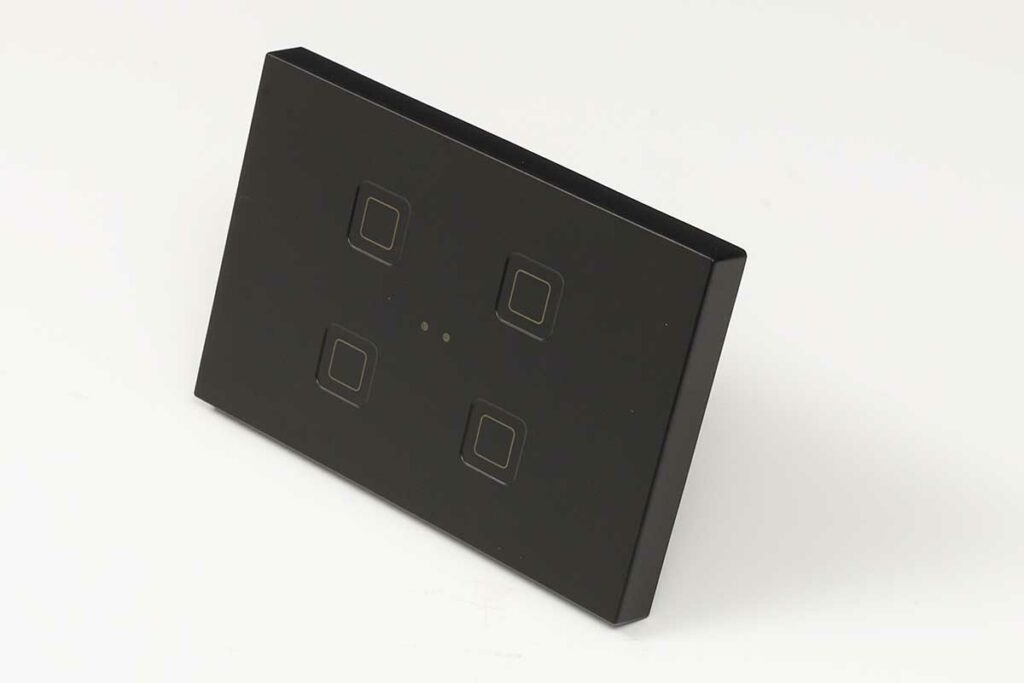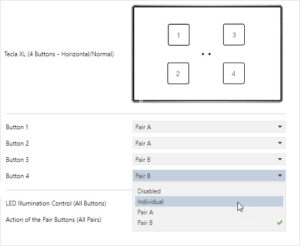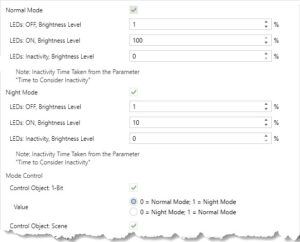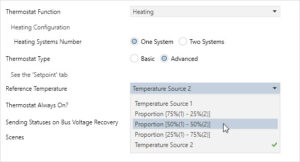The Zennio Tecla XL
Late last year the Ivory Egg crew returned from Light + Building 2022 in Frankfurt with news of the Zennio Tecla XL, and it caught my eye.
What’s not to love about the Aussie mounting compatibility, the sleek, sexy look, the distinct capacitive buttons, and – as I was to find out – the proximity detection?
I embarked upon this review thinking I’d be struggling to fill a page reviewing “a switch”, but oh how wrong I was. Scratch the surface and there’s just SO much functionality embedded.
Our 4-button loaner unit was installed in the main bedroom, adding control of the new roller blinds to the switch plate. My end goal here is a switch plate that will give convenient control of the light, blinds and ceiling fan.
Features
- Mounts in Australian, European, British, Italian and American flush boxes.
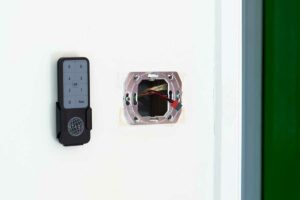
- Portrait or landscape orientation.
- Customisable button icons using Zennio’s online Touch-MyDesign site.
- In-built temperature sensor, with thermostat features in software.
- Luminosity and proximity sensor.
- Heartbeating. Handy if you have a problem with people stealing your KNX sensors I guess?
- Back-lit buttons.
Options
- Three colours: black (“Anthracite”), white and silver.
- 4, 6, 8 & 10 button versions, all in the same mounting plate – but alas, no 1- or 2-button version.
Button configuration
After setting the layout to be portrait or landscape, the buttons are configured to operate individually, as pairs (e.g. up/down), or disabled. I had hoped that a disabled button could still be used as a mimic light, its LED following the status of another Group Address, but I wasn’t able to make that happen.
In this image I’ve clicked the pull-down for button 4 to show the options:
Proximity detection
In our quest for the perfect light switch I mention the importance of being able to find the light switch by feel as you walk into the room. This “reach-around” requirement was ticked off in no time by the XL’s “proximity detection”. All you need to do is wave your hand near the plate as you enter the room and a Group Object is triggered, which I used to turn the light on to its default value.
Unfortunately this love affair turned out to be short-lived, because it’s TOO sensitive. You only need walk past the panel and it wakes, turning on the light. It does this during the day, and if the light’s already on but at a lower level, waking the panel ramps the light to an unwanted higher intensity.
I was able to mitigate this last issue by using a ‘dummy’ group address and looping through some logic in the Gira X1: if the panel object fires and the light’s already on, do nothing.
Unfortunately this didn’t help the false-triggers, so I disabled the proximity detection. That in turn led to problems finding the right button at night, and wrong actions being taken by inadvertantly triggering the wrong button. I re-enabled proximity but removed the linkage that turned the room light on. Now it only lights the backlight.
LED & backlight control
The Tecla XL is either awake or asleep, active or inactive, with separately configurable ‘normal’ (day) and ‘night’ modes for the button LEDs, which perform double-duty as the ‘backlight’. Night mode is optional, and the mode can be set by a 1-bit object or the firing of a scene.
When the panel is asleep (inactive), you set an ‘inactivity brightness’ from 0-100%. There’s no linkage to the groups the buttons control; all buttons are the same brightness. With Proximity enabled you can safely set the inactivity brightness to 0%, as there’s little need having any of the LEDs on until you approach and wake it up.
It’s only when you wake the panel that the LEDs can follow the controlled group addresses.
I struggled to get the button LEDs to mimic the channel’s status in a way I found natural, and this was hampered by the ETS screen-captures in the documentation not aligning with reality. This would be a down-side of Zennio crafting free-standing PDFs for each feature, then linking each product to the pre-existing feature description PDFs.
When ‘LED Illumination Control’ is set to ‘State-Dependent (Where Available)’, the LED in the top (up/on) button lights when the group is on, and the bottom one lights when it’s off. Changing this to ‘State-Dependent (Where Available) (Both LEDs)’, then both LEDs in the pair follow the on status.
To beep or not to beep
You have control over whether the buttons beep to acknowledge a press. I experimented with both (as I thought it’s not the most pleasant tone) and settled for leaving it on. You can enable and disable the beep through a control object, so you can perhaps mute the beeps at night, although that might give rise to reports of it only beeping intermittently.
It would have been more expensive to add, but I prefer the physical ‘whack’ of the plate that some other touch switches provide, and of course that’s more subtle too.
Alarm & Doorbell
I thought the included doorbell and alarm functionality was kinda cute, with the former not something I’d previously considered porting across to KNX (but I am now!).
The implementation’s perhaps a little lacking, with only two ‘sounds’ from which to choose, both of which are almost the same shrill beep. On triggering the doorbell the panel sounds a single 1s beep, whilst an alarm is the same sound repeated continuously at a ~1/2Hz rate, until a button is pressed to acknowledge it. I went looking for a group object to confirm the panel acknowledged the alarm, but none was to be found, something that I thought would have been a nice-to-have.
Light & temperature
I didn’t have a particular need for the light and temperature controls, so I didn’t explore these features in much detail, beyond assigning some dummy Group Addresses and setting the panel to broadcast the values as they changed. As is common-place in KNX sensors, the panel can send its temperature every ‘n’ seconds, and/or when the temperature changes by ‘n’ x 0.1°C. It can also send an alarm if the sensor reports it’s too hot or cold in the room, which I could probably find a use for. (There are separate group objects for overheating and overcooling.)
The ‘ambient luminosity sensor’ fires a binary object or a scene: it’s either light (‘over threshold’) or dark (‘under threshold’). You set percentage values for the brightness and hysteresis.
Thermostat
Separate to the temperature sensor is full Thermostat control, which looks to be incredibly powerful. It can control heating, cooling or both. Check out the feature’s dedicated PDF for more on that.
I noted that the thermostat ‘Configuration’ page lets me set the reference temperature from a combination of either the internal temperature sensor or an external one, however the XL doesn’t appear to have an external input. This code is presumably shared with other models in the family and has yet to be fully customised to this hardware platform.
Summary
Pros
- They fit a standard Aussie mounting plate. (YAY!!)
- Customisable button icons, although this needs to be defined when ordering.
- SO MANY configuration options.
- Plentiful documentation on config and operation (although it’s not without error at the time of writing).
Cons
- The proximity detection is too sensitive and can’t be adjusted.
- The only illumination colour is white, and I found it confusing discerning between the backlight and the controlled Group’s status.
- I would have liked more control of the button LEDs.
- The inbuilt speaker is quite tinny and limited in the sounds it can make, and there’s no volume control capability.
- It’s a minor niggle, but as the buttons come from the factory with your custom button labelling you can’t repurpose them later if your needs change or you want to move the buttons around.
- The absence of 1- or 2-button versions might present a problem maintaining consistency throughout your installation.
- Some rough edges are apparent in the code and documentation that will presumably be corrected in due course.
Rocky suggested that the Tecla XL’s probably more intended for commerical use than domestic, and of course our focus here is the latter.
The issues above notwithstanding, I was quite impressed by the Tecla XL, and I’m hoping that some of the shortcomings can be addressed in future firmware updates.
The bespoke button printing looks great, and I was surprised to learn it adds only a ~10% premium for a totally customised factory-quality labelling.
If you really only want the button functionality you’re probably paying a little extra for the unwanted luminosity, proximity and temperature sensors, but the price still seems quite reasonable, and presumably being able to standardise on a reduced number of SKUs means a lower ultimate cost to the end user.
Resources
- The product page @ Zennio.
- Ivory Egg’s “product spotlight“.
Thanks
Thanks to Sydney @ IvoryEgg for the loan of the reviewed 4-channel unit.
… and as always Rocky for the photos.
Revision History
17th February 2023: This is the initial publication.
– G.
